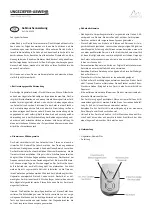
5. MAINTENANCE, ADJUSTMENTS AND CALIBRATION
Page 163
© 2009 DH Instruments, a Fluke Company
5.11.2.2
LOW PRESSURE ISOLATION VALVE LEAK
To identify the low pressure isolation valve in the PPCH schematic, see Section
3.2.1, Figure 9.
PPCH includes a low pressure isolation valve only if it has an internal Lo Q-RPT.
To localize a leak to the low pressure isolation valve, proceed as follows:
If the PPCH
TEST
port is not already
plugged, plug it with a DH500 gland and
plug.
Use
[RANGE]
to make the Hi Q-RPT or
utility sensor active (see Section 3.3.1).
Vent the PPCH and disconnect electrical
power and drive air supply.
Open the PPCH chassis to gain access to
the mechanical module (see Section 5.9).
Loosen the low pressure isolation valve
bracket retaining hardware (two button
head bolts).
Using a 1/2 in. wrench, loosen the two
DH200 high pressure connections on the
pressure tube between the isolation
valve and the high pressure cross.
Slide back the valve assembly in the
mounting slots to fully remove the
loosened tube.
Install a DH200 gland and plug (supplied
with PPCH accessories) in the open port
of the high pressure cross where the
tube was removed.
Reapply drive air supply, connect
electrical power and power on the
PPCH.
Perform a pressure decay based leak
check (see Section 5.11.1).
If the leak is no longer present then the
low pressure isolation valve is the cause
of the leak and the valve should be
replaced (see Section 5.12.1).
If the leak is still present, there is a leak
that is not in the low pressure isolation
valve. Reconnect the original isolation
valve and proceed with additional leak
testing to localize a leak within PPCH
(see Section 5.11.2).
Step 5
Step 6
5.11.2.3
LOW PRESSURE VENT VALVE LEAK
To identify the low pressure vent valve in the PPCH schematic, see Section
3.2.1, Figure 9.
PPCH includes a low pressure vent valve only if it has an internal Lo Q-RPT.
















































